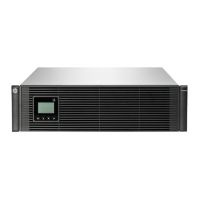What does 'Battery DC Over Voltage' mean on my HP R5000?
- EelizabethdudleySep 2, 2025
The HP UPS displays 'Battery DC Over Voltage' when battery voltage levels have exceeded the maximum allowable limits.

What does 'Battery DC Over Voltage' mean on my HP R5000?
The HP UPS displays 'Battery DC Over Voltage' when battery voltage levels have exceeded the maximum allowable limits.
What does 'Shutdown Imminent' mean on my HP R5000 UPS?
If your HP UPS showing 'Shutdown Imminent', it indicates that the UPS has entered a state where it might stop operating abruptly without notice.
Why does my HP UPS show 'Input Under/Over Frequency'?
The HP UPS displays 'Input Under/Over Frequency' when the utility frequency is outside of the usable frequency range.
Why does my HP R5000 UPS show 'Input AC Under Voltage'?
The HP UPS displays 'Input AC Under Voltage' when the utility RMS voltage is less than the minimum valid utility threshold.
Why does my HP R5000 show 'Input AC Over Voltage'?
The HP UPS displays 'Input AC Over Voltage' when the utility RMS voltage exceeds the maximum valid utility threshold.
What does 'Output Overload Level 3' indicate on my HP UPS?
If your HP UPS displays 'Output Overload Level 3', it means that the load levels are greater than a level 3 threshold.
What does 'Output Overload Level 2' mean on my HP R5000 UPS?
If your HP UPS is showing 'Output Overload Level 2', it indicates that the load levels are greater than a level 2 Overload condition but less than a level 3 Overload condition.
| Output Voltage | 230V |
|---|---|
| Form Factor | Rack-mountable |
| Rack Height | 3U |
| Nominal Output Voltage | 230V |
| Topology | Double Conversion Online |
| Input Voltage | 230V |
| Frequency | 50/60 Hz |
| Battery Recharge Time | 3 hours |
| Transfer Time | 0 ms |
| Operating Temperature | 0 - 40 °C |
| Battery Type | Sealed Lead Acid (SLA) |
| Interface | USB, Serial |
| Output Power Capacity | 4500 Watts |
| Efficiency | 95% |
| Power Capacity | 5000 VA |
| Dimensions | 43.2 x 66 x 13 cm |
Provides an overview of the HP UPS R5000 features, capabilities, and benefits.
Details critical safety instructions for operating and maintaining the UPS to prevent injury.
Explains the function and usage of the Remote Emergency Power Off (REPO) port.
Lists important safety and handling precautions before installation.
Step-by-step guide to physically installing the UPS unit into the rack.
Instructions for connecting the UPS battery leads safely.
Details on how to connect the REPO port, including safety warnings.
How to connect the UPS to the main power source.
Guidance on connecting equipment to the UPS output receptacles.
Information on how to charge the UPS batteries before use.
Introduction to configuring the UPS Network Module.
Steps to access and log into the UPS Network Module web interface.
Details on configuring settings via the web interface.
Steps for installing the Extended Runtime Module (ERM).
Describes the different operating modes of the UPS.
Steps to safely power down the UPS.
Overview of the HP Power Protector software and its features.
Guide for replacing the hot-swappable Network Module.
Introduction to the process of replacing UPS batteries.
Crucial safety warnings related to battery handling.
Step-by-step procedure for replacing UPS batteries.
Instructions for removing and replacing the entire UPS unit.
Steps for removing and replacing the Extended Runtime Module (ERM).
Guidance on how to update the UPS firmware.
Guide to identifying and resolving UPS alarms.
Troubleshooting steps for battery connection issues.
Diagnosing and resolving situations where bypass mode is unavailable.
Steps to take for general alarm conditions.
Troubleshooting steps for out-of-range input voltage.
Diagnosing issues with low battery warnings.
Troubleshooting steps for internal UPS faults.
Addressing issues related to low battery shutdowns.
Troubleshooting steps for overload conditions.
Diagnosing and resolving REPO related conditions.
